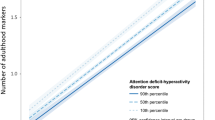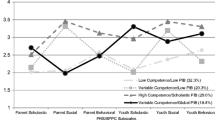Abstract
In recent years, there has been an increasing focus on the role of future expectations—the extent to which a future outcome is deemed likely—in the health and well-being of adolescents, with research linking future expectations to outcomes such as an increased likelihood of engaging in risky health behaviors. As yet, however, there has been no research on future expectations and attention deficit/hyperactivity disorder (ADHD) in adolescence. To address this research gap, the current study examined the association between ADHD symptoms/possible ADHD status and future expectations in a school-based sample of adolescents. Data were analyzed from 537 Russian adolescents (aged 12–17) with teacher-reported ADHD symptoms and self-reported future expectations. Logistic regression analysis was used to examine associations. In fully adjusted analyses, inattention symptoms/possible ADHD inattentive status was associated with lower future educational expectations, while a possible ADHD hyperactivity status was associated with increased odds for negative future expectations relating to work, family and succeeding in what is most important. The findings of this study suggest that greater ADHD symptoms/possible ADHD status in adolescence may be linked to an increased risk for negative future expectations across a variety of different life domains.

Similar content being viewed by others
References
American Psychiatric Association (2013) Diagnostic and statistical manual of mental disorders, 5th edn. APA, Arlington
Befera MS, Barkley RA (1985) Hyperactive and normal girls and boys: mother-child interaction, parent psychiatric status and child psychopathology. J Child Psychol Psychiatry 26(3):439–452
Bourchtein E, Langberg JM, Owens JS, Evans SW, Perera RA (2017) Is the positive illusory bias common in young adolescents with ADHD? A fresh look at prevalence and stability using latent profile and transition analyses. J Abnorm Child Psychol 45(6):1063–1075
Christie D, Viner R (2005) Adolescent development. BMJ 330(7486):301–304
Das D, Cherbuin N, Butterworth P, Anstey KJ, Easteal S (2012) A population-based study of attention deficit/hyperactivity disorder symptoms and associated impairment in middle-aged adults. PLoS ONE 7(2):e31500
Dubow EF, Arnett M, Smith K, Ippolito MF (2001) Predictors of future expectations of inner-city children: a 9-month prospective study. J Early Adolesc 21(1):5–28
Duncan GJ, Dowsett CJ, Claessens A, Magnuson K, Huston AC, Klebanov P, Pagani LS, Feinstein L, Engel M, Brooks-Gunn J, Sexton H, Duckworth K, Japel C (2007) School readiness and later achievement. Dev Psychol 43(6):1428–1446
DuPaul GJ, Power TJ, Anastopoulos AD, Reid R (1998) ADHD Rating Scale-IV: checklists, norms, and clinical interpretation. Guilford, New York
Epstein JN, Conners CK, Erhardt D, Arnold LE, Hechtman L, Hinshaw SP, Hoza B, Newcorn JH, Swanson JM, Vitiello B (2000) Familial aggregation of ADHD characteristics. J Abnorm Child Psychol 28(6):585–594
Frazier TW, Youngstrom EA, Glutting JJ, Watkins MW (2007) ADHD and achievement: meta-analysis of the child, adolescent, and adult literatures and a concomitant study with college students. J Learn Disabil 40(1):49–65
Griffin KW, Botvin GJ, Nichols TR, Scheier LM (2004) Low perceived chances for success in life and binge drinking among inner-city minority youth. J Adolesc Health 34(6):501–507
Hallberg U, Klingberg G, Setsaa W, Moller A (2010) Hiding parts of one’s self from others—a grounded theory study of teenagers diagnosed with ADHD. Scand J Disabil Res 12(3):211–220
Hurtig T, Ebeling H, Taanila A, Miettunen J, Smalley S, McGough J, Loo S, Järvelin MR, Moilanen I (2007) ADHD and comorbid disorders in relation to family environment and symptom severity. Eur Child Adolesc Psychiatry 16(6):362–369
Iovu MB (2015) Future expectations of senior high schoolers in Romania. Int J Adolesc Youth 20(4):518–527
Iovu MB, Hărăguş PT, Roth M (2018) Constructing future expectations in adolescence: relation to individual characteristics and ecological assets in family and friends. Int J Adolesc Youth 23(1):1–10
Isaksson J, Stickley A, Koposov R, Ruchkin V (2018) The danger of being inattentive—ADHD symptoms and risky sexual behaviour in Russian adolescents. Eur Psychiatry 47:42–48
Jaekel J, Wolke D, Bartmann P (2013) Poor attention rather than hyperactivity/impulsivity predicts academic achievement in very preterm and full-term adolescents. Psychol Med 43(1):183–196
Jensen CM, Steinhausen HC (2015) Comorbid mental disorders in children and adolescents with attention-deficit/hyperactivity disorder in a large nationwide study. Atten Defic Hyperact Disord 7(1):27–38
Jessor R, Donovan JE, Costa FM (1992) Rocky mountain middle/high school study health behavior questionnaire. Questionnaire guide. Institute of Behavioral Science, University of Colorado, Boulder
Johnston C, Mash EJ (2001) Families of children with attention-deficit/hyperactivity disorder: review and recommendations for future research. Clin Child Fam Psychol Rev 4(3):183–207
Kaplan BJ, Crawford SG, Fisher GC, Dewey DM (1998) Family dysfunction is more strongly associated with ADHD than with general school problems. J Atten Disord 2(4):209–216
Lahey BB, Applegate B, McBurnett K, Biederman J, Greenhill L, Hynd GW, Barkley RA, Newcorn J, Jensen P, Richters J et al (1994) DSM-IV field trials for attention deficit hyperactivity disorder in children and adolescents. Am J Psychiatry 151(11):1673–1685
Loe IM, Feldman HM (2007) Academic and educational outcomes of children with ADHD. J Pediatr Psychol 32(6):643–654
McGee R, Williams S, Silva PA (1984) Background characteristics of aggressive, hyperactive, and aggressive-hyperactive boys. J Am Acad Child Psychiatry 23(3):280–284
Merrell C, Sayal K, Tymms P, Kasim A (2017) A longitudinal study of the association between inattention, hyperactivity and impulsivity and children’s academic attainment at age 11. Learn Individ Differ 53:156–161
Murphy K, Barkley RA (1996) Attention deficit hyperactivity disorder adults: comorbidities and adaptive impairments. Compr Psychiatry 37(6):393–401
Nguyen QC, Hussey JM, Halpern CT, Villaveces A, Marshall SW, Siddiqi A, Poole C (2012a) Adolescent expectations of early death predict young adult socioeconomic status. Soc Sci Med 74(9):1452–1460
Nguyen QC, Villaveces A, Marshall SW, Hussey JM, Halpern CT, Poole C (2012b) Adolescent expectations of early death predict adult risk behaviors. PLoS ONE 7(8):e41905
Nurmi JE (1991) How do adolescents see their future? A review of the development of future orientation and planning. Dev Rev 11(1):1–59
Nurmi JE (2005) Thinking about and acting upon the future: development of future orientation across the life span. In: Strathman A, Joireman J (eds) Understanding behavior in the context of time. Theory, research, and application. Lawrence Erlbaum Associates, Publishers, Mahwah, pp 31–57
Pingault JB, Tremblay RE, Vitaro F, Carbonneau R, Genolini C, Falissard B, Côté SM (2011) Childhood trajectories of inattention and hyperactivity and prediction of educational attainment in early adulthood: a 16-year longitudinal population-based study. Am J Psychiatry 168(11):1164–1170
Power TJ, Costigan TE, Leff SS, Eiraldi RB, Landau S (2001) Assessing ADHD across settings: contributions of behavioral assessment to categorical decision making. J Clin Child Psychol 30(3):399–412
Prince DM, Epstein M, Nurius PS, King K, Gorman-Smith D, Henry DB (2016) Assessing future expectations of low-income minority young men: survival-threats and positive expectations. J Child Fam Stud 25(7):2089–2101
Prince DM, Epstein M, Nurius PS, Gorman-Smith D, Henry DB (2019) Reciprocal effects of positive future expectations, threats to safety, and risk behavior across adolescence. J Clin Child Adolesc Psychol 48(1):54–67
Radloff LS (1977) The CES-D Scale: a self-report depression scale for research in the general population. Appl Psychol Meas 1(3):385–401
Raffaelli M, Koller SH (2005) Future expectations of Brasilian street youth. J Adolesc 28(2):249–262
Rodriguez A, Järvelin MR, Obel C, Taanila A, Miettunen J, Moilanen I, Henriksen TB, Pietiläinen K, Ebeling H, Kotimaa AJ, Linnet KM, Olsen J (2007) Do inattention and hyperactivity symptoms equal scholastic impairment? Evidence from three European cohorts. BMC Public Health 7:327
Ruchkin V, Schwab-Stone M, Vermeiren R (2004) Social and Health Assessment (SAHA): psychometric development summary. Yale University, New Haven
Ruchkin V, Lorberg B, Koposov R, Schwab-Stone M, Sukhodolsky DG (2008) ADHD symptoms and associated psychopathology in a community sample of adolescents from the European north of Russia. J Atten Disord 12(1):54–63
Sasser TR, Kalvin CB, Bierman KL (2016) Developmental trajectories of clinically significant attention-deficit/hyperactivity disorder (ADHD) symptoms from grade 3 through 12 in a high-risk sample: predictors and outcomes. J Abnorm Psychol 125(2):207–219
Sayal K, Washbrook E, Propper C (2015) Childhood behavior problems and academic outcomes in adolescence: longitudinal population-based study. J Am Acad Child Adolesc Psychiatry 54(5):360–368
Schmid KL, Phelps E, Lerner RM (2011) Constructing positive futures: modeling the relationship between adolescents’ hopeful future expectations and intentional self regulation in predicting positive youth development. J Adolesc 34(6):1127–1135
Scholtens S, Rydell AM, Yang-Wallentin F (2013) ADHD symptoms, academic achievement, self-perception of academic competence and future orientation: a longitudinal study. Scand J Psychol 54(3):205–212
Sipsma HL, Ickovics JR, Lin H, Kershaw TS (2015) The impact of future expectations on adolescent sexual risk behavior. J Youth Adolesc 44(1):170–183
Steinberg L, Morris AS (2001) Adolescent development. Annu Rev Psychol 52:83–110
Thompson R, Wiley TRA, Lewis T, English DJ, Dubowitz H, Litrownik AJ, Isbell P, Block S (2012) Links between traumatic experiences and expectations about the future in high risk youth. Psychol Trauma 4(3):293–302
Valadez-Meltzer A, Silber TJ, Meltzer AA, D’Angelo LJ (2005) Will I be alive in 2005? Adolescent level of involvement in risk behaviors and belief in near-future death. Pediatrics 116(1):24–31
Woodward L, Taylor E, Dowdney L (1998) The parenting and family functioning of children with hyperactivity. J Child Psychol Psychiatry 39(2):161–169
Wyman PA, Cowen EL, Work WC, Kerley JH (1993) The role of children’s future expectations in self-system functioning and adjustment to life stress: a prospective study of urban at-risk children. Dev Psychopathol 5(4):649–661
Funding
AK's work was supported by the Miguel Servet contract financed by the CP13/00150 and PI15/00862 Projects, integrated into the National R + D + I and funded by the ISCIII—General Branch Evaluation and Promotion of Health Research—and the European Regional Development Fund (ERDF-FEDER). These organizations had no role in the study design, collection, analysis, and interpretation; in the writing of the manuscript; and in the decision to submit the paper for publication.
Author information
Authors and Affiliations
Corresponding author
Ethics declarations
Conflict of interest
The authors declare that they have no conflict of interest.
Ethical approval
All procedures performed in studies involving human participants were in accordance with the ethical standards of the institutional and/or national research committee and with the 1964 Helsinki Declaration and its later amendments or comparable ethical standards.
Informed consent
Informed consent was obtained from all individual participants included in the study.
Additional information
Publisher's Note
Springer Nature remains neutral with regard to jurisdictional claims in published maps and institutional affiliations.
Rights and permissions
About this article
Cite this article
Stickley, A., Koposov, R., Kamio, Y. et al. Attention deficit/hyperactivity disorder and future expectations in Russian adolescents. ADHD Atten Def Hyp Disord 11, 279–287 (2019). https://doi.org/10.1007/s12402-019-00292-w
Received:
Accepted:
Published:
Issue Date:
DOI: https://doi.org/10.1007/s12402-019-00292-w




